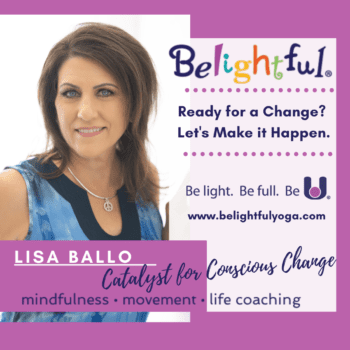It bombards you with distracting thoughts and nagging worries that seem too powerful to handle.

If you suffer from anxiety, you can feel paralyzed by it. You begin to confuse your thoughts with elements of your core self and soon have trouble differentiating between legitimate concerns and unproductive worrying.
But mindfulness can help.
Mindfulness eases anxiety by teaching you to recognize these destructive patterns and acknowledge them for what they are – simply thoughts. In this way, you are far less likely to get carried away by anxiety.
How Can You Be Mindful When Anxiety Strikes?
“Become mindful” may seem a ludicrous suggestion in the battle against anxiety. Especially when you’re in the throes of an unreasonable exaggeration of threats, repetitive negative thinking, hyper-arousal, and fear – all of which throw you into the fight-or-flight response.
You may also experience physical symptoms such as rapid heartbeat, light-headedness, high blood pressure, and digestive issues. These can become so severe that it’s difficult to take part in everyday life.
So just how can an anxious person be expected to practice mindfulness when there’s so much overload? How does that even work?
Mindfulness Eases Anxiety By Embracing Anxiety
When anxiety enters the body, rather than kicking into fight-or-flight mode, Buddhist monk Pema Chödrön recommends you “lean into it.”
This may seem counter-intuitive. Your first reaction is to avoid or withdraw from it. But when you open up to anxiety and the thoughts instead and fully realize your experience, it takes away the power. The distressing cease to carry as much truth.
By practicing responding to those disruptive thoughts rather than reacting to them, you can begin to let them go.
Sounds simple enough, right?
Well, it is a practice. And as with all practices, it does take some work. So we’ll take a look at ways you can start practicing mindfulness in your everyday life. And don’t worry. None of them requires you to sit in a cave in the Himalayas for hours on end.
1. Set an Intention
If you’ve ever taken a yoga class, you may have noticed the teacher asked you to set an intention for your practice.
Even if you’ve never entered a yoga studio, setting an intention is a great way to enter into any situation. It helps you focus and reminds you why you’re doing something.
When we go through life on autopilot, there’s no awareness and this creates fertile ground for getting swept up by anxiety and fear. Without that focus, you’re putting out the welcome mat for the distressing thoughts to enter in again.
So the next time you have to do something that makes you anxious, try setting an intention first.
2. Practice Beginner’s Mind
Bringing a fresh perspective to an everyday situation has tremendous value.
For example, say that you drive the same route to work every day. You see the same signs, same buildings, same streetlights. What would it take to make the journey new each time?

Start by engaging your senses. Listen to any sounds you hear as if it’s the first time. Observe one of those buildings in a way you haven’t before. In other words, be willing to adopt another point of view. You just may be surprised at how much you discover.
If you’re able to approach anxiety with that same willingness and curiosity, you’ll start to see new possibilities that will transform your experience. Look at it anew. Rather than slipping into habitual and reactionary thoughts and feelings, be open to what it has to teach you.
3. Steer Clear of Judgment
This is a tough one.
It’s all too easy to judge when you feel anxious. This can be a reaction to the discomfort you’re experiencing and only ends up piling more upon those already unsettling feelings.
If you can try to practice being in the present moment though without evaluating everyone and everything around you (including yourself), you’ll see things more clearly.
The truth is, judgment creates sources for anxiety to thrive. By adopting a nonjudgmental stance, you’re giving your mind the opportunity to work from a more balanced and peaceful state.
4. Wish Others Happiness
While being nonjudgmental may seem like an insurmountable feat (it’s not by the way), you only need 10 seconds to wish for someone to be happy. That’s it.
Here’s how it works. When you’re struggling with anxiety, randomly wish for someone to be happy. It can be someone you know or a stranger at your place of work, the gym, a restaurant, wherever.
You don’t need to say anything to the person. In your head, simply wish they find happiness. That’s it. This simple mindful practice is especially powerful when you find you’re annoyed or upset with the person for whom you’re wishing happiness.
5. Give Yourself a Break
Is all of this direction to be mindful making you feel anxious? Don’t worry!
You’re not trying to be consciously mindful during every moment of your day. Attempting to do so would create anxiety for anyone. It’s equally important that you give yourself some time to let go and unwind.

Let your mind wander and see where it takes you. As you continue to periodically practice mindfulness, those thoughts will have less power. Eventually, you’ll be able to observe those thoughts without letting anxiety take the wheel and drive.
Could You Benefit from More Mindfulness?
It’s clear that mindfulness eases anxiety. Unfortunately, we live in a world of overstimulation that doesn’t exactly encourage peaceful practices that incorporate mindfulness.
So if you’re interested in how a mindful practice could help your business, school, or organization, contact us today.
We provide mobile yoga/relaxation/mindfulness classes to help you find peace right where you are.



